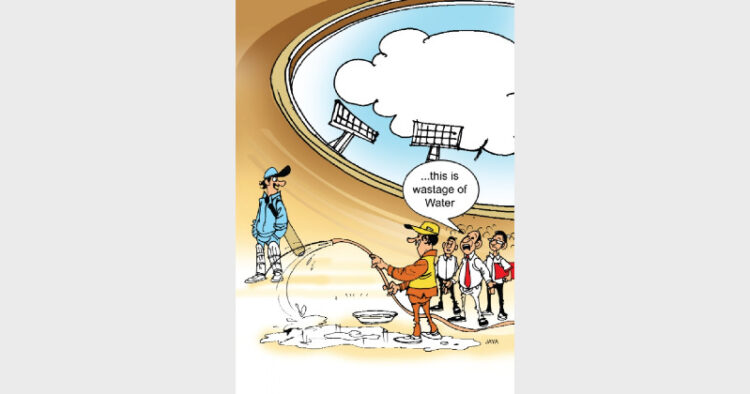-Shantanu Guha Ray –
Enough heat and dust have dominated breaking headlines in televisions and front pages of the dailies on a meaningless debate over whether water meant for spraying cricket fields should be saved for parched regions of drought-hit Maharashtra. What many missed in India was that the slugfest was nothing but an iceberg argument (meaning what you see is nothing as compared to what you don’t).
The Indian Paani League argument, as a television channel has tagged its prime time show, looked like a desperate attempt to drum up television ratings, which in turn ensures more advertisements and that ensures more cash for the channel. Everyone loves to see images of parched earth deliciously contrasted with cheer girls, cricketers and corporate captains in special boxes in the stadium.
The drought and cricket debate has made Indian media a laughing stock, many cricket playing nations who follow developments in Indian cricket are aghast at the arguments over water. Actually, they have filled the twitter space and Facebook with questions ranging from why this argument did not come up during ICC T20 World Cup. Worse, how other sectors are routinely using water in Maharashtra without much clamour.
Let’s get some figures. Four to six million litres of water are used to maintain each IPL ground. There are over 25 golf courses in Maharashtra which routinely consume over 200 million litres water every day but do not find space in the debate that is currently being argued in television channels. Have the owners stopped watering the golf courses? The answer is a Big No.
Using water for cricket has not happened overnight, grounds have been watered for decades, and cricket has never been seen as a deterrent to something as catastrophic as drought. For instance, Maharashtra has been reeling under drought for over three years– areas in Vidarbha and Karnataka have seen a huge epidemic of farmer suicides. But why link cricket to water to produce bouts of hypocritical hysteria?
A seasoned economist, Surjit Bhalla, has even argued against the near hyperbolic uses of water by the sugarcane industry and said cricket grounds did nothing in comparison, ostensibly because the grass in cricket used re-circulated water unfit for consumption. Over half of Maharashtra’s irrigation water goes to sugarcane that accounts for 6 per cent of irrigated area. That has not changed because almost all politicians in the state have a stake or two in the sugarcane sector. And they love cricket, too.
The Indian Premier League is the world’s richest. Obviously, there are some who feel everything that is rich is bad and there must be something unholy about it and every form of entertainment must be laced with a tinge of sin. They cite the example of cricket being the rich man’s game – they do not know golf is more expensive – and they talk of spot fixing, without bothering to understand that the death of Hansie Cronje did not kill cricket in South Africa. India won two World Cups despite ghosts of fixing routinely bothering the Men in Blue. The game grew despite the glitches.
The IPL is a $5 billion (Rs 33,175 crore) brand and contributed a little over $15 billion (Rs 99,525 crore) in the country’s GDP. And it is one of the three touchstones of popular culture in India that functions as a morality play, the other two being Hindi Cinema and politics.
It is hence, grossly misplaced to link the game to water, one of the most contentious products across the world? And what is the logic in shifting the game to other parts of the country? Maharashtra would lose revenues, the earnings going to other states. But what happens if those states also start reeling under drought? There are enough such signs, right? And the world’s richest cricket league is not ending overnight. It is expected to stretch till the end of May, bang peak of Indian summer.
The water and cricket mix is totally out of place. But it’s heartening that the sport has helped people sit up and take notice of a situation that has been in existence for decades. The government of Maharashtra is taking a serious re-look at the people of Latur and Marathwada, even television anchors have flown down from their palaces to do some ground level reporting.
Perhaps it is time to use the country’s most followed sport to usher some interesting, workable social changes. Ask the BCCI, it would even organise a charity show to supplement earnings for the drought hit people. Ask IPL franchise owners to contribute a slice of sponsorship/gate money to fund more water trains to the parched regions like Latur.
If that happens, it would be a great leveller. Cricketers have never refused participation for any social causes or selfie moments. Let’s use them to merge Bharat into India.
(The writer is Senior Journalist
and Author)














Comments